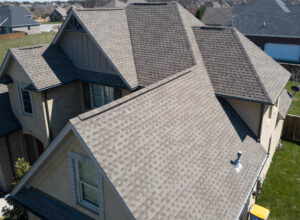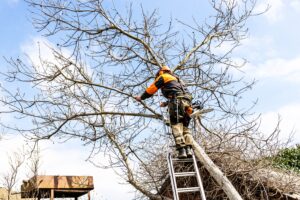10 Secrets to Extending Your Roof’s Life: Proven Strategies for Homeowners

Imagine a roof that lasts for decades, standing strong against the elements and saving you thousands in repairs. Sound too good to be true? It’s not – with the right maintenance strategies, you can make it a reality. Follow these ten simple strategies to maximize your roof’s lifespan and prevent costly repairs in the future.

1. Gentle Cleaning Methods to Preserve Your Shingles
While power washing can effectively clean your roof, it can also cause damage to the shingles and underlying materials. The high-pressure water can dislodge granules from asphalt shingles, weakening their protective layer and exposing them to premature aging. Instead, consider using a soft-bristle brush and a gentle cleaning solution to remove dirt and debris from your roof.
2. Unclog Gutters to Prevent Water Damage
Clogged gutters can cause water to back up and seep under your shingles, leading to rot, mold, and other forms of damage. Make it a habit to clean your gutters at least twice a year, preferably in the spring and fall. This simple task can go a long way in preventing costly roof repairs.

3. Remove Leaves, Moss, and Mold for a Healthier Roof
Leaves, moss, and mold not only make your roof look unsightly but can also contribute to its deterioration. Regularly removing these elements from your roof can help extend its lifespan.

4. Insulate Your Attic for Temperature Consistency
Proper attic insulation plays a crucial role in maintaining a consistent temperature in your home, preventing ice dams from forming on your roof during the winter months. Ice dams can cause water to back up under your shingles, leading to leaks and potential damage to your roof’s structure.
5. Ensure Proper Ventilation to Prevent Moisture Buildup
Adequate attic ventilation is essential for preventing moisture buildup, which can lead to rot, mold, and other forms of damage. Ensure that your attic has sufficient vents and that they are not blocked, allowing for proper air circulation.
6. Schedule Regular Professional Inspections
Regular roof inspections are crucial for identifying and addressing potential issues before they become major problems. Hire a professional roofing contractor to inspect your roof at least once a year, preferably in the fall before winter weather sets in. They can identify and repair any loose, cracked, or missing shingles, as well as check for signs of damage or wear and tear.

7. Carefully Remove Snow and Ice Accumulation
Heavy snow and ice buildup can put significant strain on your roof, potentially causing it to collapse or sustain damage. After a heavy snowfall, carefully remove excess snow from your roof using a roof rake or hire a professional to do it for you. Avoid using sharp tools or damaging your shingles in the process.
8. Address Chimney Issues Promptly
If your home has a chimney, it’s essential to keep it in good condition. Cracked or deteriorating chimneys can allow water to seep into your roof, causing significant damage. Have a professional inspect your chimney regularly and make any necessary repairs to prevent water intrusion.

9. Trim Overhanging Branches to Avoid Damage
Overhanging tree branches can scratch and damage your roof’s surface, leaving it vulnerable to leaks and other issues. Additionally, fallen branches or debris from trees can puncture or dislodge shingles. Regularly trim any trees near your home to prevent potential damage to your roof.
10. Invest in Wind- and Storm-Resistant Features
High winds and severe storms can wreak havoc on your roof, causing shingles to blow off or sustain damage. Consider installing hurricane clips or other wind-resistant features to help secure your roof during extreme weather events. Moreover, inspect your roof after any major storm for signs of damage and make necessary repairs promptly.
Why Extending Your Roof’s Lifespan Matters
A well-maintained roof can prevent costly water damage, mold growth, and structural issues that can compromise the integrity of your home. Additionally, prolonging the life of your roof can save you money in the long run by delaying the need for a complete roof replacement, which can be a significant expense.
Understanding the Lifespan of Different Roofing Materials
A roof’s durability and lifespan can vary depending on the type of material used, the quality of installation, and the maintenance it receives. Here’s a general overview of the average lifespan of different roofing materials:
- Asphalt Shingles: 15-30 years
- Wood Shingles or Shakes: 20-40 years
- Clay or Concrete Tiles: 50-100 years
- Metal Roofing: 40-70 years
- Slate Roofing: 75-200 years
Recognizing When It’s Time for a New Roof
Even with proper maintenance, all roofs will eventually reach the end of their lifespan and require replacement. Here are some signs that it may be time to consider getting a new roof:
- Curled, cracked, or missing shingles
- Leaks or water stains on ceilings or walls
- Granules from asphalt shingles accumulating in gutters
- Excessive moss or mold growth on the roof
- Sagging or uneven areas on the roof
- Age of the roof (near or beyond its expected lifespan)
If you notice any of these signs, it’s advisable to have a professional roofing contractor inspect your roof and provide recommendations.
Frequently Asked Questions About Roof Maintenance
Q: How often should I have my roof inspected?
A: Don’t leave your roof’s health to chance! Schedule a professional roof inspection at least once a year to catch potential issues early and prevent costly damage. Be proactive and give your roof the attention it deserves.
Q: Can I clean my roof myself?
A: While DIY roof cleaning may seem tempting, it’s not worth the risk. Improper techniques or equipment can damage your shingles and lead to premature aging. Leave it to the pros – they have the expertise and tools to clean your roof safely and effectively.
Q: How can I prevent ice dams from forming on my roof?
A: Ice dams are a silent killer for roofs, but you can stop them in their tracks. Ensure your attic is properly insulated and ventilated to maintain a consistent temperature. After heavy snowfall, use a roof rake or hire a professional to remove excess snow and reduce the risk of ice dam formation.
Q: Should I replace my entire roof or just repair damaged areas?
A: Don’t make this decision alone – enlist the help of a professional roofing contractor. They’ll assess the extent of the damage, consider your roof’s age and material, and provide expert recommendations. In some cases, targeted repairs may suffice, while others call for a full replacement to ensure long-term protection and value for your home.
Final Thoughts
Remember, a properly maintained roof is a smart investment in protecting your home and ensuring the safety and comfort of your family. By following the strategies outlined in this article and seeking professional assistance when needed, you can maximize the life of your roof and enjoy a secure and reliable shelter for years to come.

Anna has over six years of experience in the home services and journalism industries and serves as the Content Manager at MyHomePros.com, specializing in making complex home improvement topics like HVAC, roofing, and plumbing accessible to all. With a bachelor’s degree in journalism from Auburn University, she excels in crafting localized, comprehensive guides that cater to homeowners’ unique needs. Living on both coasts of the United States has equipped her with a distinctive perspective, fueling her passion for turning any house into a cherished home through informed, personalized decision-making.








